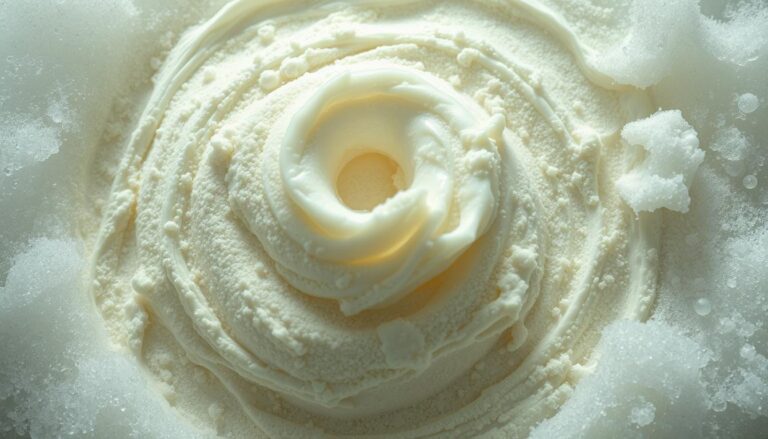Is a Broken Tooth a Dental Emergency? Find Out Now
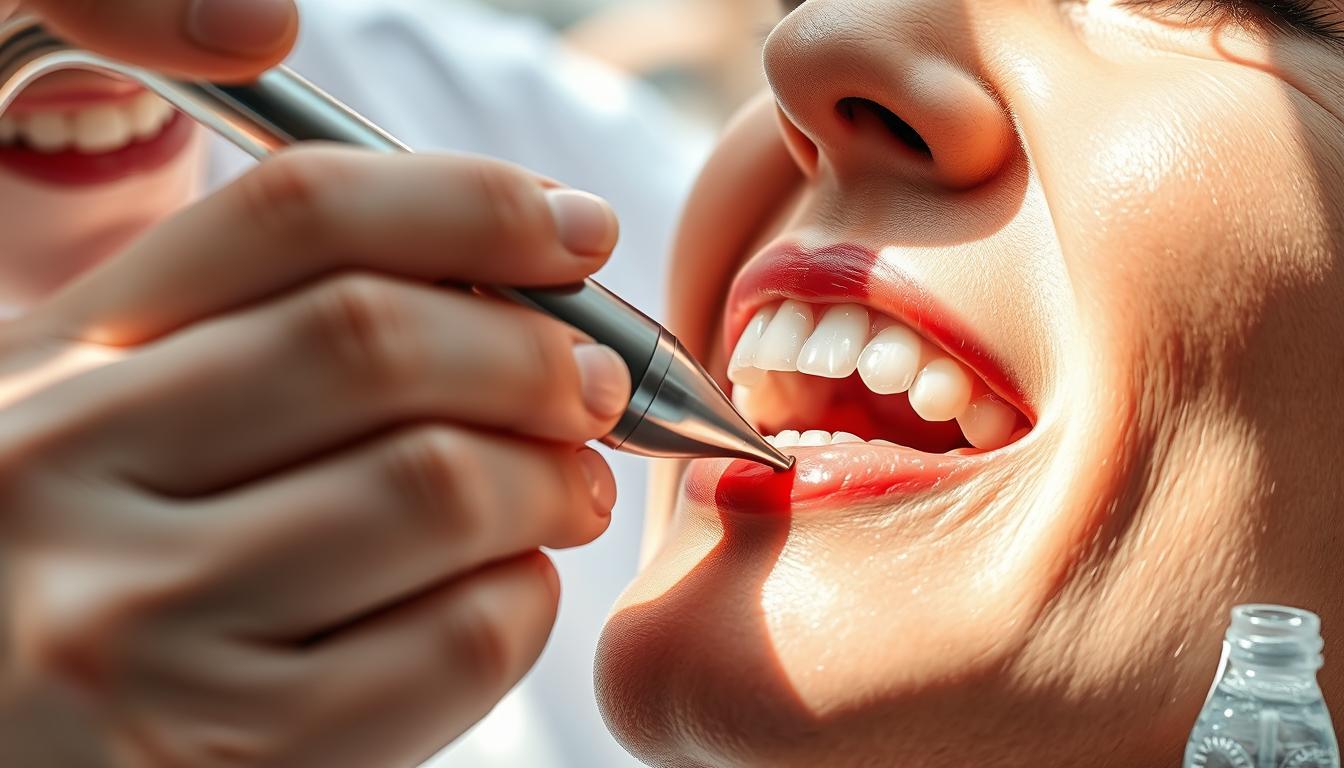
Every year, over five million teeth are knocked out in the U.S. This shows how common dental injuries are. Many ask: Is a broken tooth a dental emergency?
Teeth are incredibly strong, but accidents or biting hard objects can break them. Knowing if it’s just a small chip or a bigger break is key. Getting help fast can stop problems like infections or swelling.
Key Takeaways
- A broken tooth may signal a true dental emergency, depending on severity.
- Deep fractures can expose nerves and raise the infection risk.
- Pain, bleeding, or swelling may require immediate treatment.
- Seeking professional care early protects long-term oral health.
- Is a broken tooth considered a dental emergency? Quick evaluation is wise.
Understanding Dental Emergencies
Dental problems can get worse fast if they cause sudden pain or threaten long-term health. A broken tooth emergency often makes people wonder when to seek help. Knowing about oral health helps figure out which problems need quick action and which can wait.
Life-threatening infections or big tooth cracks need fast action. They can spread serious risks. Working together, we can reduce harm.
Definition of a Dental Emergency
An urgent dental issue is one that causes sudden pain, infection risk, or tooth damage. Signs like swelling, exposed nerves, and bleeding that won’t stop mean you need help right away.
Common Types of Dental Emergencies
Several situations are urgent, including:
- Severe toothache linked to infection
- Broken or chipped teeth with underlying nerve exposure
- Knocked-out or dislodged teeth
- Severe gum or soft tissue injuries
Spotting warning signs early can improve treatment outcomes and lessen complications.
Causes of a Broken Tooth
Many people face sudden tooth fractures, leading to a dental emergency. Weakened enamel and dentin make teeth more prone to damage. Regular checkups and early action can prevent serious problems.
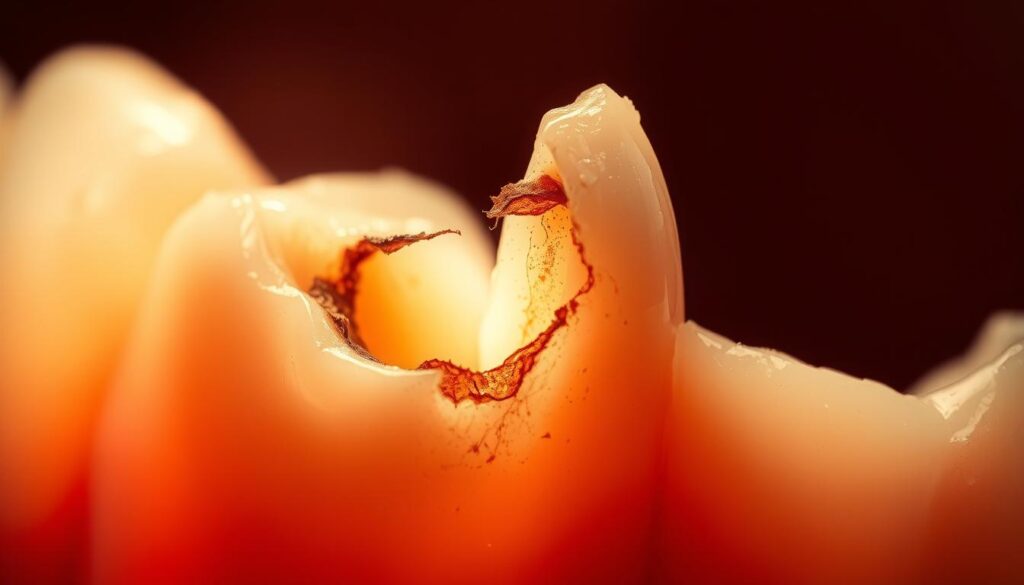
Accidents and Injuries
Falls, slips, and impacts from daily activities put teeth at risk. Even healthy teeth can break under intense pressure. Dental gear helps protect teeth from harm.
Dental Decay
Untreated cavities can weaken tooth layers, making them more likely to crack. Early detection of decay through regular exams can prevent emergencies and long-term issues.
Teeth Grinding (Bruxism)
Teeth grinding wears down enamel and can cause small fractures. It puts stress on teeth surfaces. Custom mouthguards can help reduce this stress and protect teeth.
Symptoms of a Broken Tooth
When a tooth cracks or breaks, people often notice several signs. A common question is: what to do for a broken tooth early on? Spotting these symptoms early is crucial for keeping your mouth healthy.
Pain and Discomfort
Many feel throbbing pain or a constant ache, especially when biting. This pain can even happen when you’re not eating. It’s a good idea to talk to the American Dental Association right away.
Sensitivity to Temperature
Drinking hot coffee or cold water can cause sharp pains. This usually means the dentin, a sensitive layer under the enamel, is exposed. Using special toothpaste can help ease the pain.
Visible Fractures or Chunks Missing
Some breaks are easy to see, while others are small chips. Using bright lights and mirrors can help you check. If you see a break, it’s time to call a dentist for a detailed check-up.
When to Seek Immediate Help
Severe pain or sudden damage means you need help fast. Quick action can save your teeth and prevent long-term problems. Teeth and gums are delicate, so watch for any warning signs.
Severe Pain or Bleeding
Sharp pain or bleeding that won’t stop is serious. It might mean a crack has hit a nerve. Seeing a dentist quickly can prevent more damage.
Inability to Eat or Drink
Having trouble chewing or drinking liquids is a big problem. It could be a sign of a broken tooth that needs urgent care. Getting it checked out fast can help you eat and drink again.
Signs of Infection or Swelling
Redness, bad taste, or swelling are signs of infection. These symptoms need immediate attention to avoid bigger issues. Acting fast can stop the problem from getting worse.
Temporary Solutions Until Treatment
When a tooth breaks, sudden pain can be overwhelming. Many turn to emergency dental services for quick relief from swelling or bleeding. Simple steps at home can help until a dentist can see you.
Rinsing and Cleaning the Area
Use saltwater or an antiseptic solution to rinse the area. This removes particles and lowers infection risk. It keeps the area clean without hurting sensitive spots.
Using Cold Compresses
Swelling can grow fast. A cold compress on the cheek helps by narrowing blood vessels. This reduces pain and swelling, making you feel better.
Over-the-Counter Pain Relief
Acetaminophen or ibuprofen can help with pain. But, use them carefully until a dentist can help. Always check with a doctor for the right amount and safety.
| Action | Benefit |
|---|---|
| Rinse Gently | Removes debris and lowers infection risk |
| Apply Cold Pack | Soothes tenderness and curbs swelling |
How Dentists Diagnose a Broken Tooth
Dentists use many methods to find small cracks. They look for signs like sharp pain or tiny cracks. Each step helps decide the next action.
Early detection is key for the right treatment. Damage can go deep, so a detailed check is crucial. This helps avoid more problems and improves results.
Visual Examination
Doctors look closely at the tooth’s surface for chips or cracks. They use bright lights to find issues that might be missed. This helps spot any shape or texture changes.
X-Rays and Imaging
Digital X-rays show problems hidden under the enamel. These images reveal damage that can’t be seen with the eye. New imaging tools help doctors make quick decisions.
Patient History and Symptoms
Doctors ask about recent tooth trauma or pain. They want to know about ongoing discomfort or sudden sensitivity. This helps decide if emergency treatment is needed for a full recovery.
| Diagnostic Step | Key Indicator | Outcome |
|---|---|---|
| Inspection | Visible chips | Immediate detection |
| X-Rays | Internal fractures | Precise intervention |
| Symptom Review | Biting pain | Tailored approach |
“A thorough assessment can reveal micro-cracks and guide rapid intervention.”
Treatment Options for a Broken Tooth
Dentists have many ways to fix a broken tooth. They aim to keep the tooth as it is and make sure it’s comfortable for a long time. Seeing a dentist early helps find the best fix for you and keeps your mouth healthy.
For small chips, dentists might use a simple fix. But bigger breaks need more work. They want to keep your tooth strong and look good, too.
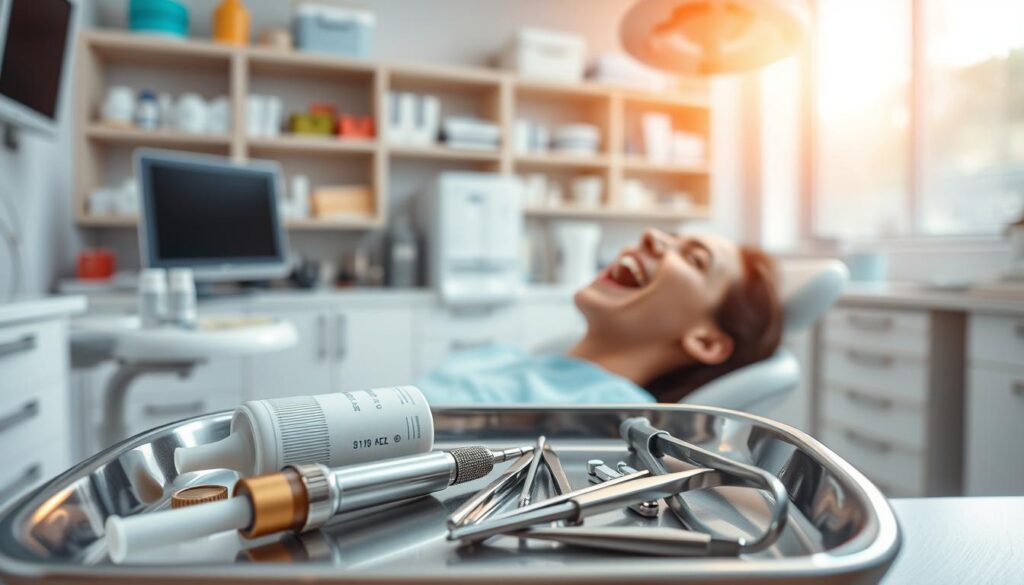
Dental Bonding
Dental bonding uses a resin that matches your tooth color. It fixes small cracks or chips. This method is quick and doesn’t need much prep.
Crowns and Caps
For teeth that are broken a bit more, crowns are a good choice. They make the tooth strong and look natural. Crowns keep the tooth safe and stop it from breaking again.
Root Canals for Severe Damage
If your tooth is really damaged, a root canal might be needed. It removes bad tissue and seals the tooth inside. This helps keep your tooth working right.
| Approach | Key Benefit | One Possible Drawback |
|---|---|---|
| Dental Bonding | Quick aesthetic fix | Less durable for heavy biting |
| Crowns and Caps | Robust protection | Requires more tooth reshaping |
| Root Canal | Removes infection | Involves longer procedure time |
Cost Considerations for Treatment
Planning your budget is key when dealing with tooth damage. Some people get advice from dental experts who use the latest technology. Quick action can lead to better results and avoid more problems.
Emergency dental care for a broken tooth can cost differently. Prices vary based on the materials, damage level, and any health issues. Dentists usually choose the best option for long-term health.
Average Costs for Repair Procedures
Repair costs depend on the procedure’s complexity:
- Minor Fillings: $100 – $300
- Bonding or Veneers: $200 – $800
- Crowns or Caps: $700 – $1,200
Prices can change based on where you are and the clinic’s fees.
Insurance Coverage Insights
Many insurers, like Delta Dental or Blue Cross Blue Shield, help pay for needed care. They cover exams, root canals, and restorations if they’re medically necessary.
Payment Plans and Financing Options
Patients can set up monthly payments or use third-party financing. This helps get emergency care sooner and prevents bigger problems. Dentists offer flexible plans to ensure quick treatment.
Preventive Measures for Dental Health
Good habits are key to keeping teeth and gums healthy. Catching small problems early can prevent big issues later. Taking care of your teeth now can save you money and pain later.
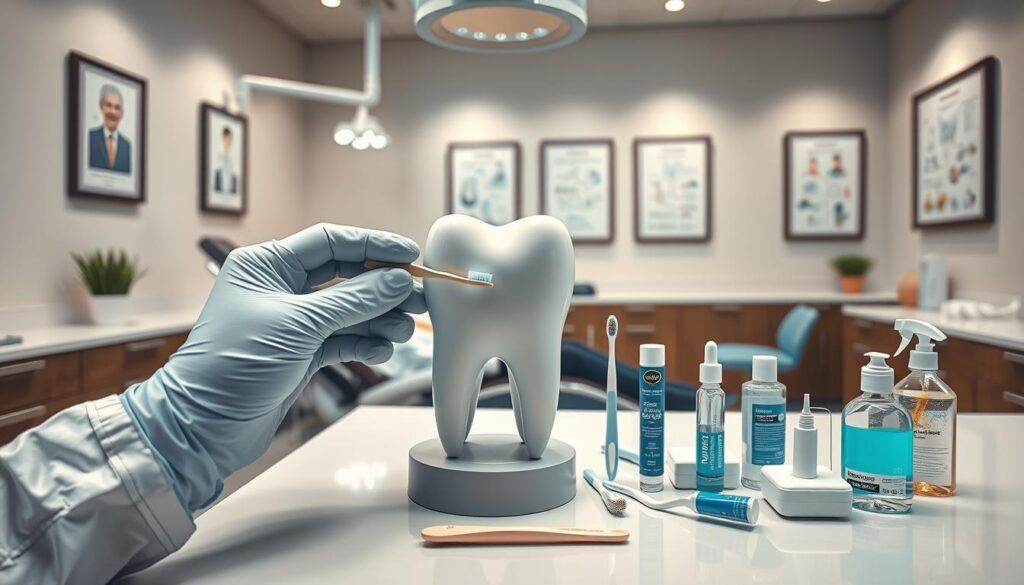
Regular Dental Check-Ups
Going to the dentist every six months is important. They can find problems before you even feel pain. This way, you avoid more serious and expensive treatments.
Maintaining Proper Oral Hygiene
Brushing and flossing regularly is crucial. It removes plaque that can harm your teeth. Adding fluoride treatments can give you extra protection against cavities. This keeps your teeth strong and can prevent emergencies.
Protective Gear for Sports Activities
Mouthguards are essential for athletes. They protect your teeth from injuries during sports. Wearing a good mouthguard can help you stay safe and keep your smile intact.
Myths and Misconceptions
Many people think a small crack in a tooth is no big deal. But, these cracks can grow and hurt the tooth’s inside. Teeth can’t heal like bones do, so it’s important to see a dentist right away.
“It’s Just a Cosmetic Issue”
A small chip can actually hurt the tooth’s deeper parts. When enamel breaks, it can expose the dentin. This can lead to pain and infection. Getting it fixed quickly can prevent bigger problems.
“Waiting Will Improve the Situation”
Some think a crack will fix itself over time. But, teeth can’t heal on their own. Waiting too long can make the problem worse, leading to more serious treatments.
“All Broken Teeth Require Extraction”
Today, dentists try to save as much of the tooth as possible. They use crowns, bonding, and other methods to fix it. Extraction is only considered when these options don’t work.
Conclusion: Importance of Prompt Care
Getting help quickly can save your tooth and prevent infection. A broken tooth might not seem like a big deal, but it’s important for your mouth’s health. The American Dental Association says seeing a dentist early can stop more problems, ease pain, and help your teeth last longer.
Recap of Dental Emergency Importance
A broken tooth can get worse if you don’t get it checked. Severe pain or swelling means you need to see a dentist right away. Doctors say quick action stops the damage from getting worse and keeps your smile looking good.
Encouragement to Seek Help Early
Seeing a dentist early can fix your tooth and keep you comfortable. It helps your body heal faster and lowers the chance of long-term infections. By acting fast, you protect your teeth for the future. This approach is in line with the latest in dental care and keeping you healthy.


